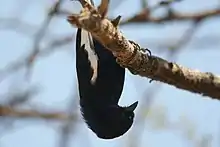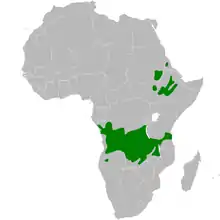| White-winged black tit | |
|---|---|
 | |
| Nominate race in Ethiopia | |
 | |
| M. l. subsp. insignis in Angola | |
| Scientific classification | |
| Domain: | Eukaryota |
| Kingdom: | Animalia |
| Phylum: | Chordata |
| Class: | Aves |
| Order: | Passeriformes |
| Family: | Paridae |
| Genus: | Melaniparus |
| Species: | M. leucomelas |
| Binomial name | |
| Melaniparus leucomelas (Rüppell, 1840) | |
 | |
| Map showing ranges of two races, respectively north and south of equator | |
| Synonyms | |
| |
The white-winged black tit (Melaniparus leucomelas) is a passerine bird in the tit family Paridae. It is also known as the white-winged tit, dark-eyed black tit or northern black tit.[2] The species was first described by Eduard Rüppell in 1840.
Description
It is mainly black with a white wing patch, but differs from the more northern white-shouldered tit (Melaniparus guineensis) with which it sometimes considered conspecific in that it has a dark eye.
Range and races
It is found in central Africa, from Angola in the west to Ethiopia in the east. There are two races:[3]
- M. l. subsp. leucomelas Rüppell, 1840 – Ethiopia, Eritrea, Sudan and South Sudan
- M. l. subsp. insignis Cabanis, 1880 – African equator to southern subtropics
Taxonomy
The white-winged black tit was formerly one of the many species in the genus Parus but was moved to Melaniparus after a molecular phylogenetic analysis published in 2013 showed that the members of the new genus formed a distinct clade.[4][5]
References
- ↑ BirdLife International (2017). "Melaniparus leucomelas". IUCN Red List of Threatened Species. 2017: e.T22731092A118693774. doi:10.2305/IUCN.UK.2017-3.RLTS.T22731092A118693774.en. Retrieved 12 November 2021.
- ↑ Gosler, A. & Clement, P. (2019). "Dark-eyed Black Tit (Melaniparus leucomelas)". In: del Hoyo, J., Elliott, A., Sargatal, J., Christie, D. A. & de Juana, E. (eds.). Handbook of the Birds of the World Alive. Lynx Edicions, Barcelona. Retrieved 26 November 2019.
- ↑ "White-winged Black Tit (Parus leucomelas) - HBW 12, p. 731". Internet Bird Collection. Retrieved 27 June 2016.
- ↑ Johansson, U.S.; Ekman, J.; Bowie, R.C.K.; Halvarsson, P.; Ohlson, J.I.; Price, T.D.; Ericson, P.G.P. (2013). "A complete multilocus species phylogeny of the tits and chickadees (Aves: Paridae)". Molecular Phylogenetics and Evolution. 69 (3): 852–860. doi:10.1016/j.ympev.2013.06.019. PMID 23831453.
- ↑ Gill, Frank; Donsker, David (eds.). "Waxwings and their allies, tits & penduline tits". World Bird List Version 6.1. International Ornithologists' Union. Retrieved 15 February 2016.
- Gill, Frank B.; Slikas, Beth; Sheldon, Frederick H. (2005). "Phylogeny of titmice (Paridae): II. Species relationships based on sequences of the mitochondrial cytochrome-b gene". Auk. 122 (1): 121–143. doi:10.1642/0004-8038(2005)122[0121:POTPIS]2.0.CO;2.
External links
 Media related to M. leucomelas at Wikimedia Commons
Media related to M. leucomelas at Wikimedia Commons Data related to M. leucomelas at Wikispecies
Data related to M. leucomelas at Wikispecies- Sound recordings, xeno-canto
